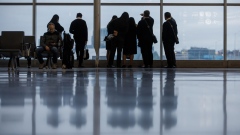Jun 19, 2024
Rising UK Homelessness Keeps Housing Crunch in Front of Voters
, Bloomberg News

(Bloomberg) -- Britain’s soaring homeless population has emerged as another symptom of a crisis in housing that’s pushed the issue up the political agenda ahead of next month’s election, with campaigners saying the main parties aren’t doing enough to deliver affordable places to live.
Almost 90,000 households were reported as homeless by councils in England in 2023 — the highest in the decade that these statistics have been recorded, according to a Bloomberg analysis of data from 317 local authorities. The figures make the nation a world leader in the number of people classed as homeless.
The number of rough sleepers also has increased during the 14 years Rishi Sunak’s Conservative Party has held office, while house prices and the cost of renting has soared. The figures highlight concern that authorities are unable to provide a place to stay for all the people who qualify as “unintentionally homeless” as required by law.
“The UK housing market is broken,” said Darren Baxter, principal policy adviser for housing and land at the Joseph Rowntree Foundation, a non-partisan charity looking how to reduce poverty. “Many people are living in private rented accommodation. That means they face both spiraling rent, but also this structural insecurity that private renting brings.”
The shortage of housing — both in the private market and so-called social homes subsidized by the government — is one of the burgeoning demands on public spending — from defense to health care and transport — that will leave either Sunak or Labour leader Keir Starmer with difficult decisions after election on July 4.
Housing has become a flash point after a surge in mortgage rates and a slow drip of new construction made buying a property increasingly less affordable. It’s one of the four top issues for voters, according to polling by YouGov Plc, and has recently overtaken the environment as a concern.
Labour, which leads by some 20 points in polls, is promising 1.5 million new homes over the next five years and to establish a cross-government “Ending Homelessness Unit” overseen by its deputy leader Angela Rayner. The Conservatives pledge 1.6 million new homes and action on rough sleeping.
But soaring rents and a lack of social housing is forcing more people into the streets and temporary accommodation, as local authorities are unable to keep up with demand from people who qualify for subsidized homes.
“The crisis is underpinned by a fundamental lack of supply in the market,” said Tom Darling, campaign manager for the Renters’ Reform Coalition.
Neither parties outline how they will achieve their building targets, most of which will come from private-sector developers. The Centre for Economics and Business Research estimates the nation needs 90,000 new social homes a year for supply to keep up with a growing population.
“Proof is in the pudding,” Conor O’Shea, campaign manager for Generation Rent, said. “What’s been laid out in the Labour manifesto is capable of causing positive change.”
Parliament first created a requirement for the government to provide housing in 1919 after thousands of soldiers returned from World War I needing a place to live. The state’s responsibility to house working people has expanded, resulting in 4 million households in England, or 17% of the total, living in social housing. That portion closely trails the 19% that live in private rentals. More than two-thirds are in owner-occupied places.
Social housing is leased by local authorities to qualifying tenants, generally those on lower incomes, below market value. The benefit for society and the Treasury is that those in social housing typically stay longer in their homes, spend less on rent and are able to work more stably.
But the pool of social housing stock has shrunk. Supply has declined with demolitions and Right to Buy — a program introduced by Conservative Prime Minister Margaret Thatcher in 1980 that enables tenants to purchase the government-owned property they live in at a market discount. Labour officials plan to review the program if they win the election.
In the absence of sufficient social housing stocks to accommodate soaring waiting lists, many would-be social renters are taking up tenancies in the private sector. By pushing the most vulnerable tenants into the private sector, the shortage has left a growing segment of the population already struggling with the cost-of-living crisis fearful they’ll soon have nowhere to live — one of the reasons polls show voters angered with the Conservative government.
“There’s a large number of people who simply don’t earn enough to be able to afford the prices that currently prevalent in the market,” said Nick Spyropoulos, managing director at Alma Economics. “Fundamentally you have someone in a home they cannot afford.”
The private sector is exacerbating the gap. The Bank of England’s decision to lift interest rates to a 16-year high and the Treasury’s clampdown on tax breaks for landlords prompted property owners to sell up, reducing the supply of places available to rent.
“The human and financial costs that comes with having to like uproot your life multiple times over a few year period is really significant, and that is affecting a much broader range of the population than it would have done 10 years ago,” Baxter said.
Landlords controversially only need to give their tenants two months’ notice of eviction, which campaigners say drives up homelessness by being too short a period for many people to find alternative accommodation. The Tories had pledged to reform this in their 2019 manifesto but failed to do so before Parliament was dissolved for the election.
“I am sorry we couldn’t get that done,” Sunak said on LBC on Wednesday morning.
(Updates with comment from Sunak. An earlier version corrected the spelling of Spyropoulos.)
©2024 Bloomberg L.P.







